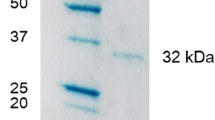Summary
Mycelia of Claviceps purpurea CBS 164.59 which produce clavine alkaloids and ergometrine were immobilized in different matrices. These mycelia exhibited a high sensitivity to extreme physical and chemical treatment, and only a moderate immobilization in calcium alginate proved to be the appropriate method to yield high alkaloid amounts. The alkaloid production is correlated to the amount of biomass. The patterns of alkaloid yields of 4% calcium alginate immobilized cells, compared to free cells, were reduced but not shifted in their maximum. With increasing calcium alginate concentrations (5%–8%) an increase of the alkaloid production even higher than that of free mycelia could be observed. Immobilization of mycelia in 8% calcium alginate resulted in a 35% increase (mg alkaloids/l medium) in overall alkaloid production. Because of reduced O2-diffusion into the beads, high calcium alginate concentrations induced a shift in the clavine alkaloid production: 8% calcium alginate immobilized cells produced agroclavine as main product whereas free cells oxidized agroclavine with molecular oxygen to produce elymoclavine and excreted this alkaloid as main product.
Similar content being viewed by others
References
Abbott BJ (1977) Immobilized cells. In: Perlman D (ed) Annual reports on fermentation processes, vol I. Academic Press, New York, pp 205–233
Bethke H, Delz B, Stich K (1976) Deterination of the content and purity of Ergotamine preparations by means of high-pressure-liquid chromatography. J Chromatogr 123: 193–203
Brodelius P (1978) Industrial applications of immobilized biocatalysts. Adv Biochem Eng 10: 75–129
Bucke C (1983) Immobilized cells. Philosophical transactions of the Royal Society of London, Series B, Biological Sciences, pp 355–369
Chibata J (1979) Immobilized microbial cells with polyacrylamide gel and carrageenan and their industrial applications. In: Venkatasubramanian K (ed) Immobilized microbial cells. ACS Symposium, Series 106. American Chemical Society Washington D.C., pp 187–202
Freeman A, Aharonowitz Y (1981) Immobilization of microbial cells in crosslinked prepolymerized linear polyacrylamide gels: antibiotic production by immobilized Streptomyces clavuligerus cells. Biotechnol Bioeng 23:2747–2759
Jindra A, Ramstad E, Floss HG (1968) Biosynthesis of ergot alkaloids. Peroxidase and the conversion of agroclavine to elymoclavine. Lloydia 31: 190–196
Kelleher WJ (1969) Ergot alkaloid fermentations. Adv Appl Microbiol 11: 211–244
Kennedy JF (1982) A future for immobilized cell technology. Nature 299: 775–779
Kolot FB (1980) Immobilized microbial systems: present state of development. Dev Ind Microbiol 21: 295–304
Kopp B, Rehm HJ (1980) Entwicklung und Toxinbildung von Aspergillus flavus im Festbettreaktor/Füllkörperreaktor. Acta Biotechnol
Morikawa Y, Karube I, Suzuki S (1979) Penicillin G production by immobilized whole cells of Penicillium chrysogenum. Biotechnol Bioeng 21: 261–270
Pazoutova S, Slokoska LS, Nikolova N, Angelov TI (1982) Sugar and phosphate metabolism and alkaloid production phase in submerged cultures of two Claviceps strains. Eur J Appl Microbiol Biotechnol 16: 208–211
Rehacek Z (1980) Ergot alkaloids and their biosynthesis. Adv Biochem Eng 14: 33–60
Robbers JE, Eggertt WW, Floss HG (1978) Physiological studies on ergot: time factor influence on the inhibitory effect of phosphate and the induction effect of tryptophane on alkaloid production. Lloydia 41: 120–129
Stadler PA (1982) Neuere Ergebnisse der Mutterkornalkaloid-Forschung. Planta Medica 46: 131–145
Stahl E (1967) Dünnschichtchromatographie. Ein Laboratoriumshandbuch. Springer, Berlin Heidelberg New York, pp 432–434
Suzuki S, Karube I (1979) Production of antibiotics and enzymes by immobilized whole cells In: Venkatasubramanian K (ed) Immobilized microbial cells. ACS Symposium, Series 106. American Chemical Society, Washington D.C., pp 59–72
Veelken M, Pape H (1982) Production of tylosin and nikkomycin by immobilized Streptomyces cells. Eur J Appl Microbiol Biotechnol 15: 206–210
Venkatasubramanian K, Vieth WR (1979) Immobilized microbial cells. In: Bull J (ed) Progress in industrial microbiology, vol 15. American Chemical Society, Washington D.C., pp 61–630
Voigt R (1959) Zur Bestimmung der Mutterkornalkaloide mit p-Dimethylaminobenzaldehyd. Microchim Acta 4: 619–630
Vorlop KD, Klein J (1981) Formation of spherical chitosan biocatalysts by ionotropic gelation. Biotechnol Lett 3: 9–14
Author information
Authors and Affiliations
Rights and permissions
About this article
Cite this article
Kopp, B., Rehm, H.J. Alkaloid production by immobilized mycelia of Claviceps purpurea . European J. Appl. Microbiol. Biotechnol. 18, 257–263 (1983). https://doi.org/10.1007/BF00500489
Received:
Issue Date:
DOI: https://doi.org/10.1007/BF00500489




